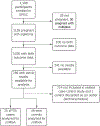Cervical microRNA expression and spontaneous preterm birth
- PMID: 36280145
- PMCID: PMC9772144
- DOI: 10.1016/j.ajogmf.2022.100783
Cervical microRNA expression and spontaneous preterm birth
Abstract
Background: Preterm birth remains a major public health issue affecting 10% of all pregnancies and increases risks of neonatal morbidity and mortality. Approximately 50% to 60% of preterm births are spontaneous, resulting from preterm premature rupture of membranes or preterm labor. The pathogenesis of spontaneous preterm birth is incompletely understood, and prediction of preterm birth remains elusive. Accurate prediction of preterm birth would reduce infant morbidity and mortality through targeted patient referral to hospitals equipped to care for preterm infants. Two previous studies have analyzed cervical microRNAs in association with spontaneous preterm birth and the length of gestation, but the extent to which microRNAs serve as predictive biomarkers remains unknown.
Objective: This study aimed to examine associations between cervical microRNA expression and spontaneous preterm birth, with the specific goal of identifying a subset of microRNAs that predict spontaneous preterm birth.
Study design: We performed a prospective, nested, case-control study of 25 cases with spontaneous preterm birth and 49 term controls. Controls were matched to cases in a 2:1 ratio on the basis of age, parity, and self-identified race. Cervical swabs were collected at a mean gestational age of 17.1 (4.8) weeks of gestation, and microRNAs were analyzed using a quantitative polymerase chain reaction array. Normalized microRNA expression was compared between cases and controls, and a false discovery rate of 0.2 was applied to account for multiple comparisons. Histopathologic analysis of slides of cervical swab samples was performed to quantify leukocyte burden for adjustment in conditional regression models. We explored the use of Relief-based unsupervised identification of top microRNAs and support vector machines to predict spontaneous preterm birth. We performed microRNA enrichment analysis to explore potential biologic targets and pathways in which up-regulated microRNAs might be involved.
Results: Of the 754 microRNAs on the polymerase chain reaction array, 346 were detected in ≥75% of participants' cervical swabs. Average cervical microRNA expression was significantly higher in cases of spontaneous preterm birth than in controls (P=.01). There were 95 significantly up-regulated individual microRNAs (>2-fold change) in cases of subsequent spontaneous preterm birth compared with term controls (P<.05; q<0.2). Notably, miR-143, miR-30e-3p, and miR-199b were all significantly up-regulated, which is consistent with the 1 previous study of cervical microRNA and spontaneous preterm birth. A Relief-based, novel variable (feature) selection machine learning approach had low-to-moderate prediction accuracy, with an area under the receiver operating curve of 0.71. Enrichment analysis revealed that identified microRNAs may modulate inflammatory cell signaling.
Conclusion: In this prospective nested case-control study of cervical microRNA expression and spontaneous preterm birth, we identified a global increase in microRNA expression and up-regulation of 95 distinct microRNAs in association with subsequent spontaneous preterm birth. Larger and more diverse studies are required to determine the ability of microRNAs to accurately predict spontaneous preterm birth, and mechanistic work to facilitate development of novel therapeutic interventions to prevent spontaneous preterm birth is warranted.
Keywords: cervix; epigenomics; microRNA; noncoding RNA; pregnancy; preterm birth; spontaneous preterm birth.
Copyright © 2022 Elsevier Inc. All rights reserved.
Conflict of interest statement
Figures


References
-
- WHO. Preterm birth. Accessed February 3, 2021. https://www.who.int/en/news-room/fact-sheets/detail/preterm-birth
-
- Ananth CV, Friedman AM, Goldenberg RL, Wright JD, Vintzileos AM. Association Between Temporal Changes in Neonatal Mortality and Spontaneous and Clinician-Initiated Deliveries in the United States, 2006–2013. JAMA Pediatr. Oct 1 2018;172(10):949–957. doi:10.1001/jamapediatrics.2018.1792 - DOI - PMC - PubMed
-
- Society for Maternal-Fetal Medicine. Electronic address pso, McIntosh J, Feltovich H, Berghella V, Manuck T. The role of routine cervical length screening in selected high- and low-risk women for preterm birth prevention. Am J Obstet Gynecol. Sep 2016;215(3):B2–7. doi:10.1016/j.ajog.2016.04.027 - DOI - PubMed
Publication types
MeSH terms
Substances
Grants and funding
LinkOut - more resources
Full Text Sources

